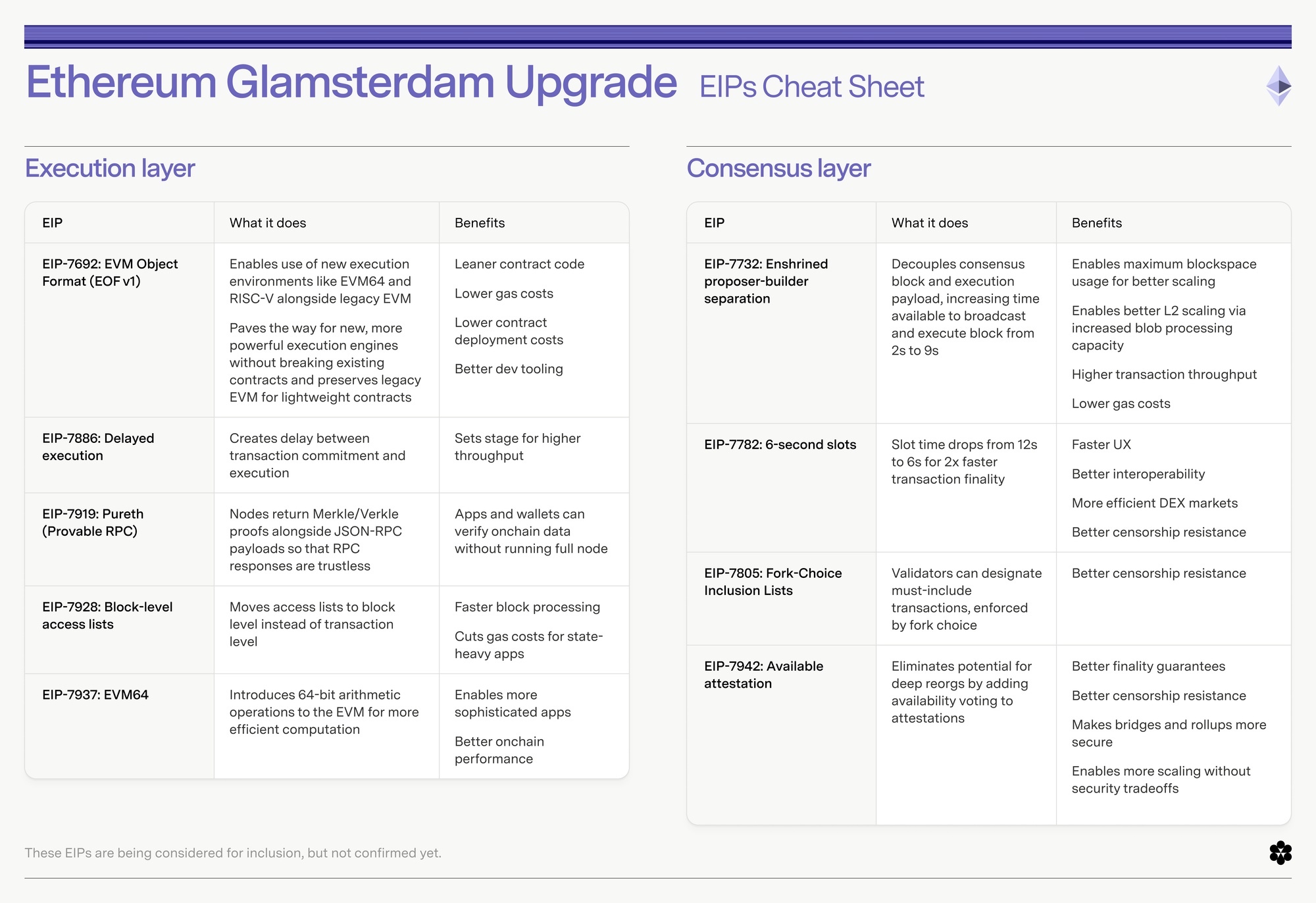Ethereum’s Glamsterdam Upgrade: Our Guide to Every Proposed EIP [July 2025]
Ethereum’s next major upgrade, Glamsterdam, is slated for early 2026. Learn about the EIPs being considered and how they can make Ethereum more scalable, efficient, and censorship-resistant.
![Ethereum’s Glamsterdam Upgrade: Our Guide to Every Proposed EIP [July 2025]](/blog/content/images/size/w1200/2025/08/glamsterdam---blog.png)
Ethereum’s next major upgrade, Glamsterdam, is slated for early 2026. Glamsterdam includes several EIPs for both Ethereum’s execution and consensus layers — one EIP per layer will be selected as a headliner and heavily prioritized for inclusion in the final upgrade. Other EIPs will still be included, but are less likely than the eventual headliners.
Glamsterdam’s primary goals are clear: Scale Ethereum’s performance, reduce costs, and increase censorship resistance. Here’s a cheat sheet breaking down the nine EIPs being considered for the upgrade:

Below, we’ll examine each of the EIPs in more detail.
Glamsterdam execution layer EIPs
EIP-7692: EVM object format (EOF v1)
EIP-7692 introduces the Ethereum Virtual Machine (EVM) Object Format, transforming how smart contracts are packaged and deployed. Instead of today's flat byte-stream, EOF adds defined sections with clear separation between executable code, static data, and metadata, alongside a version header. This structured approach enables clients to validate contracts more efficiently during deployment, removing the need for expensive, runtime JUMPDEST scanning. Developers benefit directly through reduced gas costs for contract deployment, improved tooling, and cleaner audits. EOF also opens a clear pathway toward future enhancements like 64-bit opcodes and new execution engines, all without disrupting legacy contracts.
EIP-7886: Delayed execution
EIP-7886 proposes decoupling transaction order from immediate execution by making new blocks verifiable based only on the previous state, without the need to execute the block’s transactions. Delayed execution could open the door to higher throughput thanks to reduced time to finality.
EIP-7919: Pureth (Provable RPC)
EIP-7919 would reduce trust assumptions for RPCs by allowing RPC providers to include Merkle or Verkle proofs with their RPC responses – block headers, transaction receipts, etc. Apps, wallets, and other RPC users would then get cryptographic verification that the data they’re receiving from RPC providers matches onchain state. In practical terms, this enhances security for end users and strengthens decentralization by expanding the pool of verifiable RPC providers.
EIP-7928: Block-level access lists
Currently, Ethereum supports transaction-level access lists, which specify storage keys and addresses a transaction will access, warming them up for cheaper gas costs. EIP-7928 elevates this concept, placing a single comprehensive access list in the block header, applicable to all transactions within that block. As a result, repeated access to the same keys and addresses across multiple transactions will become substantially cheaper. This is especially beneficial for state-intensive applications like DEXs and other DeFi protocols, creating considerable gas savings and greater cost predictability for both developers and end users.
EIP-7937: EVM64
EIP-7937 brings native 64-bit arithmetic and logic operations into Ethereum’s EVM. Currently, Ethereum performs all math in less efficient 256-bit chunks. EVM64 introduces specialized 64-bit opcodes, enabling significantly cheaper computations for math-heavy tasks. For developers, this drastically lowers computation costs and opens the door to more sophisticated onchain financial apps, games, and other use cases requiring complex algorithms. EIP-7937 could significantly lower the costs of ZK proofs onchain, accelerating the adoption of this important technology.
Glamsterdam consensus layer EIPs
EIP-7732: Enshrined Proposer-Builder Separation (ePBS)
EIP-7732 formally separates block proposing from block building at the consensus level. While proposer-builder separation (PBS) is widely implemented via Flashbots MEV-Boost today, enshrined PBS (ePBS) would put the mechanism entirely onchain, eliminating offchain trust assumptions. Moreover, builders gain approximately seven additional seconds per slot to assemble optimal blocks, enabling bigger payloads and higher throughput.
EIP-7782: 6-second slots
Reducing Ethereum’s current 12-second slots to six seconds, EIP-7782 significantly accelerates transaction inclusion times and reduces latency for users. Shorter slots mean quicker confirmations, improving the end user experience, particularly for time-sensitive applications like DeFi trading or gaming. Additionally, shorter slots effectively double the number of proposers, distributing rewards more broadly and enhancing Ethereum’s decentralization and resilience against censorship or collusion attacks.
EIP-7805: Fork-Choice Inclusion Lists (FOCIL)
EIP-7805 introduces an enforcement mechanism for censorship resistance. Under this model, committees of validators publish lists of transactions that must be included within a specific timeframe, enforced by fork-choice rule. Proposers who fail to include these transactions will have their blocks ignored by attesters, and may face slashing as well. FOCIL drastically strengthens Ethereum’s censorship resistance with cryptographically enforceable incentives.
EIP-7942: Available attestation
EIP-7942 adds availability voting directly to validator attestations, ensuring that the Ethereum chain only follows forks where at least one-third of the stake attests to data availability. This makes deep reorganizations and long-range attacks mathematically infeasible without significant validator collusion. For end users, it provides a robust guarantee against finality rollbacks and ensures safer, more secure interactions with bridges, L2s, and high-value DeFi applications.
Glamsterdam means big changes for Ethereum’s architecture and capabilities
Glamsterdam will likely be Ethereum’s largest and most ambitious upgrade since The Merge, combining execution and consensus layer improvements to deliver better scalability, UX, and censorship resistance. While the final set of included EIPs is still under review, Glamsterdam’s proposed changes clearly position Ethereum for a decade of continued innovation and growth.

